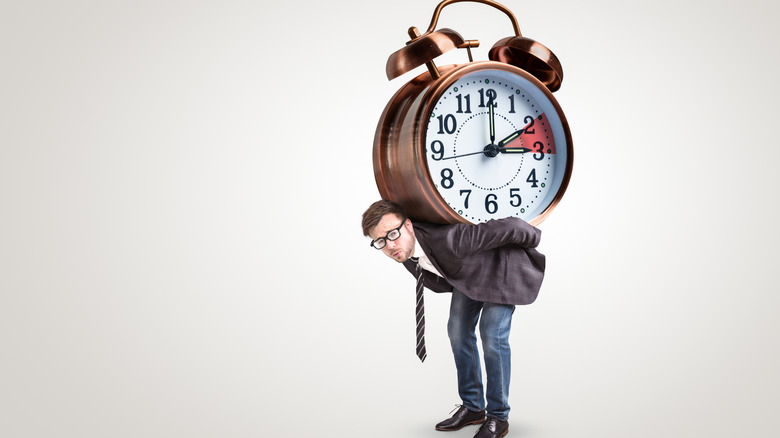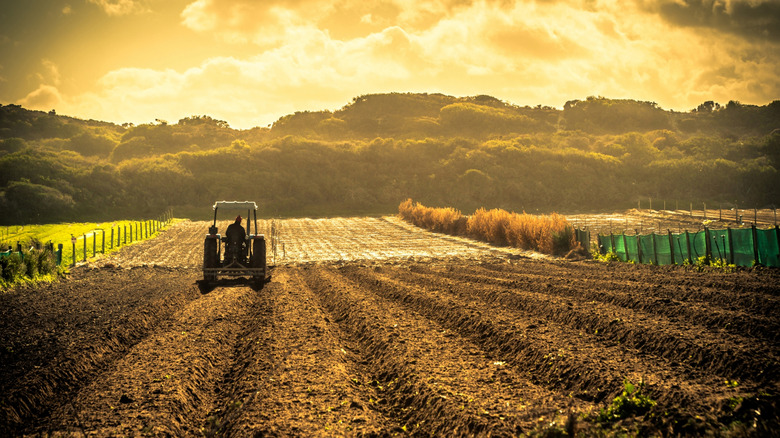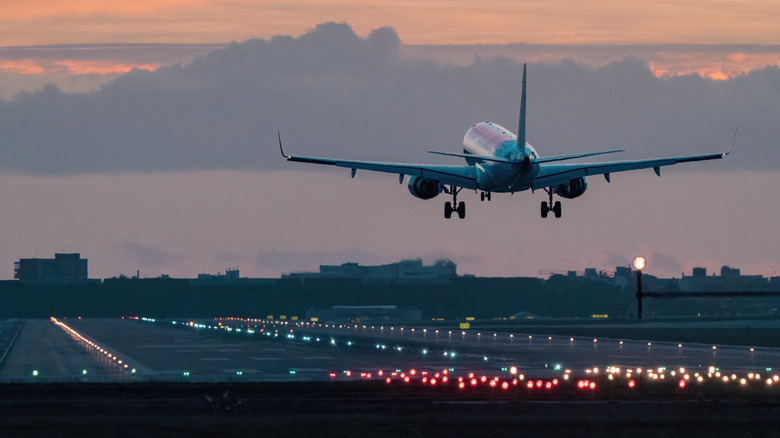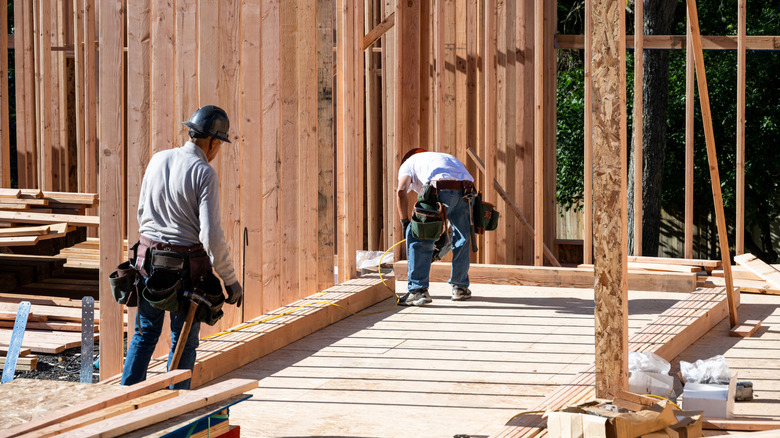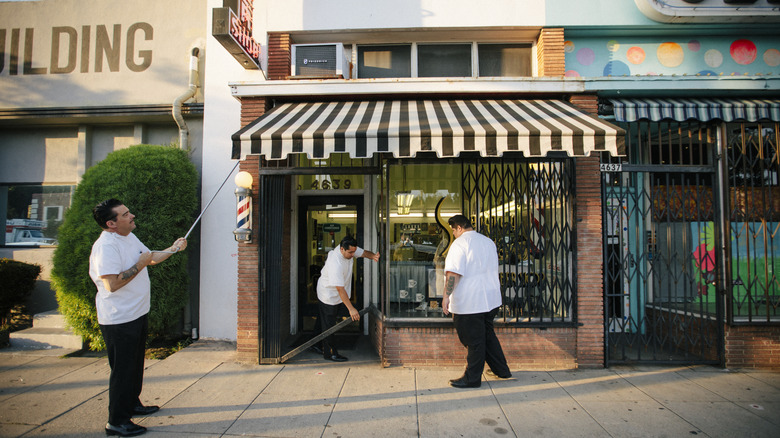The Businesses Impacted The Most By Daylight Savings Time
The yearly tradition of shifting the clocks forward (and later, back again) by an hour largely passes unnoticed today. It's frequently only spotted after the event has taken place, silently and in the background. With so many of our timekeeping devices operating on digital systems, the shift happens automatically and with little fanfare. Even without the grand, collective ceremony of dialing in a new hour on a community of wrist-worn analog clocks, the importance of Daylight Savings Time remains at the forefront of the American psyche. People in the United States and all around the world have shifted their timepieces back and forth in a delicate dance of petite hands and corresponding numbers for the last century.
The function really took root during the first World War, at a time when combatants and civilians on both sides implemented the hour shift to preserve fuel and eke out a slight improvement in the conditions of everyday life amid the calamity of global conflict. However, the concept of a pendulumatic clock governing the waking hours of humanity dates back to Benjamin Franklin. The American publisher and inventor, contrary to the generalized belief, didn't coin the idea as a means to improve the early education system or the lives of farmers. Instead, Franklin posed this biannual shift as a joke, offering it as a way to conserve candles – the overnight timekeeping tool of the era. Even so, the idea caught fire around 100 years after his first mention and came forcefully into effect shortly thereafter. Today it affects the circadian rhythms of billions alongside the interconnected global economy.
The farming community
Frequently thought of as a primary recipient of the project of moving clocks around to utilize additional sunlight hours, in reality farmers are some of the most stringent opponents of these seasonal shifts. This makes farmers a great place to begin for two reasons. First, during Benjamin Franklin's time in colonial (and later a newly established) America, a plurality of those who worked in the burgeoning community spent their days farming. The 1790 census counted around 4 million Americans with 90% of them living on farms. Today, around 2% of American families count themselves among the farming and ranching community, a dramatic shift in marketplace demands and lifestyle, indeed.
Roots of the idea aside, farming community members in the modern fabric of America are more stricken by the changeover than blessed. The shifting schedule doesn't affect crops all that much, but it can create havoc for livestock and profoundly changes the way farmers plan and operate. Farm animals aren't attuned to the clock, but have developed a rhythm throughout the day. Pushing back crucial tasks like milking or feeding disrupts that carefully set schedule. It also means that farmers frequently find themselves behind the eight ball when it comes time to harvest and bring their produce to market (or to engage in tasks like fixing their equipment – something John Deere has made much harder to accomplish in recent years). The change creates a variety of scheduling and time management headaches for those in the agricultural industry.
Golf courses (and the golf industry as a whole)
Remaining firmly within the grounding of the time shift's early days, it's perhaps unsurprising that golf courses are a major winner in this yearly dance. On the flip side of the coin from agriculturalists, golf courses and golfers alike love the ritual. Pushing back the sunset by an hour gives golfers crucial evening daylight hours to get out on the course, with this actually forming the primary rationale for its early proponents in the U.K. During the summer months not only is the day already longer than during brisk wintertime conditions, but an extra hour of visibility is added to the tee sheet. The result is a greater ability for people to get in a longer game after work. In places where golf is frequently a year-round endeavor, the sunset is pushed back by two or more hours (to nearly 8 o'clock in mid-summer Florida, for example). The result is ample time to play nine holes on just about any day after leaving the office.
Golfers experience far more enjoyment in their sporting hobby during daylight savings time, and golf courses generate greater profits as a result of this flexed ability to grab a tee time. Equipment manufacturers also benefit because golfers who are playing are more likely to buy new gear than those who have set aside their clubs for the season (old clubs worth a pretty penny might even be in greater demand during these high seasons). In fact, this seasonal shift affects just about every sporting industry (as well as the sports betting scene) that plays its games in an outdoor environment. With greater levels of evening sunlight comes increased participation in after work and after school sports.
Grocery stores
JP Morgan Chase found in 2016 that grocery stores were the most-affected business type in the entire marketplace when daylight savings time ends. Sales at grocery stores take a nosedive in November when the clocks change over to their standard orientation. With less time between working hours and the darkness of night, people are simply less inclined to stop on their way home from work and buy things. The result is perhaps a greater dedication to using a shopping list and going to the store once per week (or even less frequently) to get everything needed for extended period of time. This strategy allows busy workers to spend more of their waking free time with friends and family and less of it strolling around grocery stores that are designed precisely to keep them within their walls.
Grocery stores lose out when the clocks shift back and evening sunlight is curtailed, but it's not all bad for this industry. Consumers will always need groceries and other staple items, and shoppers don't appear to shift their brand loyalty or other aspects of the grocery shopping experience. Similarly, when the clocks spring forward again and the weather warms at the end of winter, sales tend to pick up and create it's sort of cyclical pattern of high and low profit seasonality.
Airlines (particularly international carriers)
The logistics of getting travelers where they want to go without issue or delay is a massive challenge. And that's only considering the complex scheduling demands of passenger aviation; cargo flights add a completely new dimension into this conversation. There can be as many as 20,000 planes in the sky over our world at any given time, with each one of them requiring takeoff and landing clearances alongside detailed flight plans. With the clocks shifting back and forth every year, the task of moving people and goods quickly and efficiently becomes even more difficult. To make matters worse once again, different countries change their clocks at different times of the year, and some don't move their time keeping system at all. Then there's also the unique challenge of flying through differing jurisdictions: There are eleven time zones in Russia, but only one in neighboring China.
Carriers moving passengers around a large national landscape like the United States have to account for changing time zones when flying to different regional hubs and beyond. The calculation becomes more complex when longer distances are involved, such as with flights across the Atlantic or Pacific. A unique quirk in the Pacific even allows passengers flying from Micronesia to Hawaii to "gain" nearly a full day as they cross the International Date Line. Adding the chaos of shifting times throughout the year only adds to the logistical whirlwind that flight schedulers must deal with to keep the industry afloat.
Car insurance providers
Car insurance is another industry that sees an interesting change as a result of daylight savings time coming and going. There's an average increase of about 6% in car accident volume every spring when the time change occurs. Then again at the end of the year, when clocks fall back The United States experiences a 16% uptick in accidents involving deer.
Communities that have a lot of local animal activity are particularly susceptible to increased traffic collisions involving them around these two clock shifts. While we understand the difference in time, and adjust our schedules accordingly, animals do not. They shift their behavior based on interactions with humanity, and a sudden change in human behavior is met with a slow alteration to the habits of deer and other animals. In the fall, with more animals out and about at dusk and a reduced visibility on the roadways, drivers are more likely to hit them. The result is an uptick in insurance claims, costing insurance companies more in the fall and early spring than at other times of the year.
The transportation and utilities sectors
In the same way that airlines have to deal with substantial logistical hurdles, the transportation industry as a whole is equally characterized by complex timings and Herculean scheduling efforts. The same can be said for utilities providers, with a change in daylight hours increasing the demand for electricity and other key community resources in a sudden burst of activity.
But what makes these two sectors heavily impacted by a shifting time schedule isn't primarily logistics of their workplaces, but rather the fact that these market sectors have the highest proportion of night shift workers in the United States. Over 6% of employees working in these areas spend their time on the clock overnight. With annual changes affecting what constitutes night at two separate times of the year, employees in these industries are frequently adjusting what their schedules look like. This also changes the way they interact with other marketplace elements in their communities. A night shift that starts an hour later during part of the year gives workers the ability to potentially eat dinner at home with their family before heading off to work, for instance.
Hospitals and other health service providers
The health care sector is another component of the American economy that employs plenty of night shift employees. Everyone from cleaning staff to surgical doctors can be found in a hospital around the clock. In the same way that changing time standards affect the personal lives of employees elsewhere, a night shift that sees itself moving back and forth in relation to the sunset impacts these individuals.
But that's not the only reason why hospitals and other medical service providers see a changeover in their environment. The yearly time changes lead to an increase in health issues on a regular basis. For starters, Seasonal Affective Disorder impacts the mental faculties of people everywhere during the winter months. This can lead to other related health care needs that might not otherwise come into play. There's also the reality that additional car accidents breed additional medical care requirements. With insurance companies dealing with an increased volume in insurance claims on the roads, hospitals see a correlated uptick in patients visiting their emergency rooms as a result of traffic incidents. Mental health needs, increased stress, and an exacerbation of existing heart issues all take place as a direct result of the yearly movement of the clocks.
Movie theaters
Simply put, movie theaters are impacted directly by a shift to daylight savings time because people are less likely to sit in a dark room watching a movie if it's bright outside. With more daylight hours in the day, Americans everywhere spend more time outside and doing other things instead of cozying up with a warm popcorn and consuming the newest movies out in theaters.
Theaters everywhere know this occurs and so they frequently introduce promotions and other incentives designed to drive traffic during the spring and summer months. Big blockbuster movies are also frequently slated for release during the summer in order to create inflated hype around going to the movies when kids are out of school and adults feel like they have more free time. However, this isn't always the case and plenty of heavyweight titles are released around the holidays at the end of the year, too. November and December see their fair share of big budget releases to coincide with the increase the time that people spend at home around Thanksgiving and Christmas.
Gas stations and the oil industry
When the spring kicks into full gear, not only are temperatures warmer and days longer, people are more incentivized to get out and about and spend time with friends, participate in hobbies (like golfing), or simply go for a walk somewhere in their community. In the modern world we inhabit, most commonly this involves driving in some capacity. 92% of American households owned at least one car in 2022. With personal transportation playing such a vast role in the American experience of movement (public transportation viability lags severely just about everywhere, jeopardizing young adults' financial stability in particular), increased time on the move typically means more driving.
An increase in time on the road also equates to more gas used to get where you're going. As a direct consequence, gas stations see an increase in sales during the summer months. This shift is made all the more potent by the added hour of evening daylight during these warm weather periods.
Call centers
Call centers operating worldwide are yet another business that feels a pronounced impact from the change in daylight hours. In the days and weeks surrounding a time change, callers may not be actively aware of the shift. This can lead to frustrations from some who might try to call early in the morning for support only to pick up the phone and an hour before the helpline opens for business. This also creates a knock on effect where more people frequently call in when the lines do open, putting more pressure on call center agents right as they start their day. This shift in time can also lead to added stress when planning a day around working hours for those employed in this sector. With the change in sunrise and sunset, it can put increased stress on an employee to get personal tasks done at different points of the day than usual.
Construction crews
Construction is perhaps a unique workplace in terms of Daylight Savings time changes. When the clocks spring forward, construction crews are gifted an additional hour of natural light to use at the end of the day to continue working on whatever they're building. But this change isn't necessarily going to affect their start time. This is because many jurisdictions place a moratorium on construction work before a certain hour of the day. The result can see a spiking increase in productivity, but this comes at a cost for individuals working on the project.
Of course, employers will need to pay for this additional hour of work, and not all construction companies will opt to take advantage of the extension as a result. Those that do may place an obligation on their employees to continue working an extra hour into the evening rather than running separate shifts or making the extension negotiable. Anyone who finds their day extended by an hour may not be very happy as this change in workplace demands can severely impact their free time with friends or family at the end of a long day of hard, physical work.
Local small businesses
The small businesses in any local community around the country offer an important endnote to round out this exploration. As suggested earlier, businesses of all sorts frequently see their patronage drop when the clocks fall back at the end of the year. This phenomenon is particularly pronounced when it comes to evening shopping. People leaving work after the Sun has already set are incentivized to get home as quickly as possible. The outdoor environment just isn't the same enticing arena when your morning commute is done in darkness, and your evening return back home also takes place as the Sun is setting or later.
The Chamber of Commerce has been aware of this economic impact for the last 100 years and has consistently been the chief promoter of maintaining the time change to introduce Daylight Savings Time each spring. Even as some politicians and other pundits vie for a curtailing of this fluid manner of telling time, the Chamber of Commerce has stood firm in its support. The extra hour of late sunlight prompts commuters to stop in their local community to buy things on their way home from work, impacting small businesses directly and profoundly in the process. Whether restaurants or boutique shops, the result is largely the same. Moreover, the change itself is perhaps important to boosting sales. With the annual move forward into spring comes a natural excitement about what the warmer weather and increased daylight hours have in store. Good marketing has always amplified hype wherever it can be found, and it's perhaps the anticipation of brighter days that helps spur on rejuvenated consumer participation in local marketplaces.
